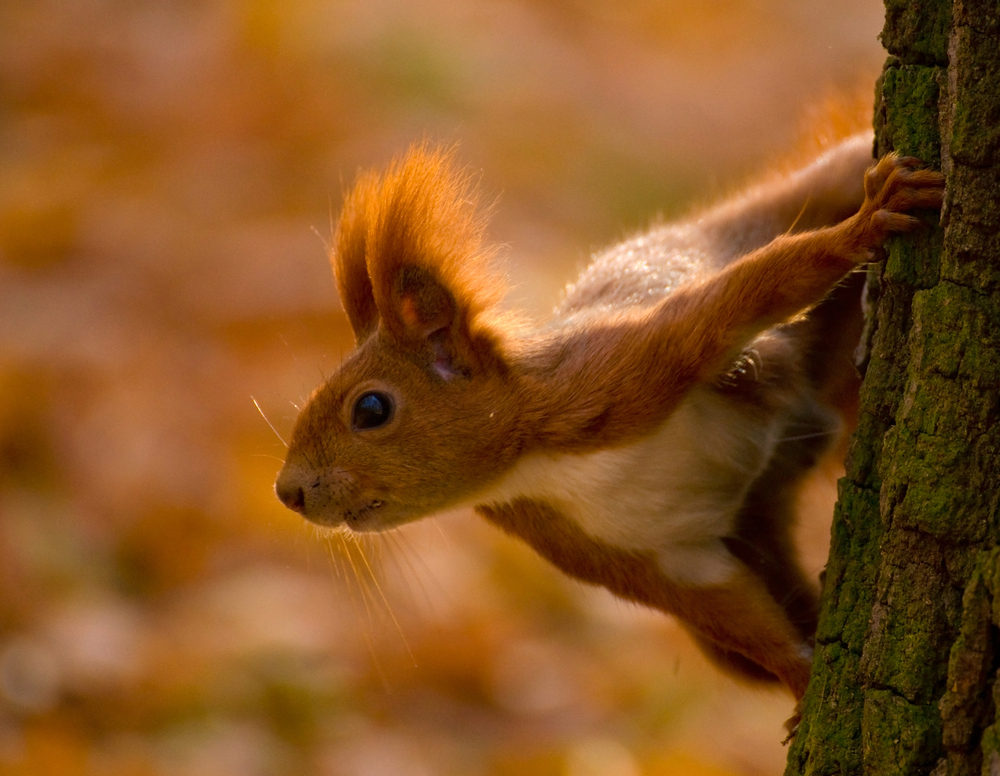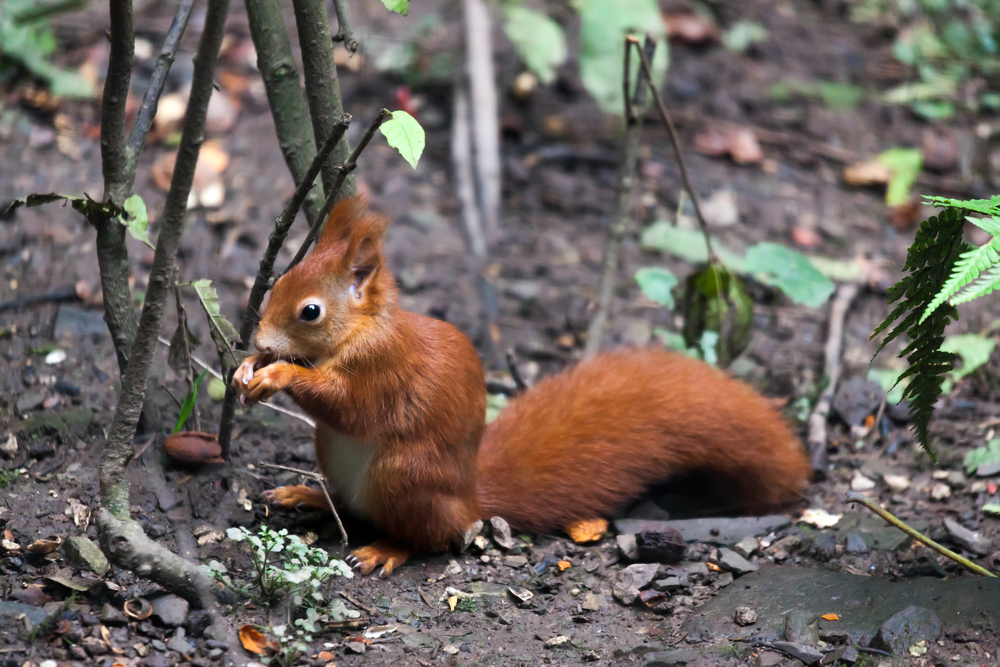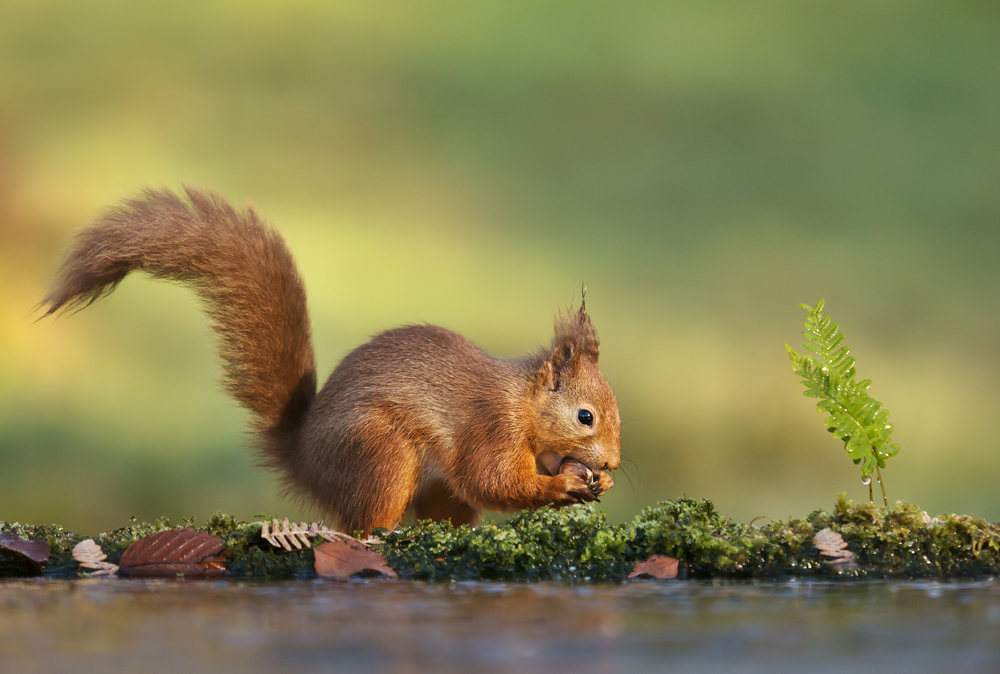The red squirrel (Sciurus vulgaris) is an iconic species of wildlife that can be found across the UK. It’s a small, bushy-tailed rodent with reddish fur and large ears. Although it may appear cute and harmless to some, its presence in our gardens or local parks often reveals fascinating insights into their diet, habitat preferences and behaviour. In this article, we’ll explore all aspects of the red squirrel (Sciurus vulgaris), from identification tips to conservation status updates, as well as observation techniques for those wishing to get up close and personal with these charismatic creatures!
How To Identify a Red Squirrel
The red squirrel is a small mammal native to the UK, and is easily identifiable by its reddish-brown fur coat. It has a slender body with large ears and eyes, and an average weight of 250–340 grams (8.8–12 ounces). Its tail is long and bushy, typically measuring between 15–20 cm (6–8 inches) in length.
The colour of the red squirrel’s fur can vary depending on the season; during summer months, it tends to be more brownish-red, while winter coats are usually greyer in tone. The underside of the animal’s body is lighter than its backside – often white or cream-coloured – which helps camouflage it from predators when foraging on the ground.
Red squirrels have sharp claws that help them climb trees quickly, as well as strong hind legs for jumping from branch to branch with ease. They also possess scent glands located near their ears which they use to mark their territory by rubbing against tree trunks or branches; this behaviour can sometimes be seen in urban parks where these animals live alongside humans.

Red Squirrel Diet
The red squirrel is an omnivorous species that mainly feeds on seeds, nuts, fruits and fungi. It will also eat buds, flowers, bark and sap from trees. During the summer months it may feed on insects such as caterpillars or beetles. In winter, it relies heavily on stored food reserves of conifer cones to survive the cold temperatures. Red squirrels are able to remember where they have hidden their caches of food which helps them during lean times when natural sources of food are scarce.
Red squirrels often forage in small groups and can be seen searching through leaf litter, looking for edible items like mushrooms or acorns. They have a varied diet but prefer certain types of foods depending on availability at different times throughout the year; for example, they favour hazelnuts over other nuts in autumn due to their higher fat content, which helps them build up energy reserves before hibernation season begins.
In some areas, red squirrels have been known to scavenge bird tables or take advantage of human-provided treats such as peanuts or sunflower hearts left out by wildlife enthusiasts hoping to attract these animals into their gardens. This type of supplementary feeding should only be done with caution, however, as too much human interference could disrupt natural behaviour patterns and potentially cause harm if not monitored correctly.

Red Squirrel Habitat
In Europe
The red squirrel prefers coniferous forests but can also be found in deciduous woodlands, scrubland, urban parks and gardens. In Europe, it is most commonly found in Scotland, England and Ireland, where its preferred habitat includes Scots pine woodland with an open canopy that allows plenty of sunlight to reach the ground below.
In the US
In North America, it inhabits boreal forest regions such as Alaska, Canada and parts of New England, where they are more likely to inhabit mixed-coniferous forests composed mainly of spruce or fir trees. They are also known to occupy areas around rivers or streams which provide them with access to food sources such as nuts and berries from nearby shrubs or trees.
In urban areas
These small mammals have adapted well to living close to humans; they often take advantage of bird feeders stocked with sunflower seeds as a source of food while using garden sheds or garages as shelter during bad weather conditions. As long as there are suitable habitats available, they will continue to thrive throughout much of their natural range despite threats posed by human activities such as deforestation and climate change which could potentially reduce their numbers over time if not addressed soon enough.

Behaviour Of Red Squirrels
Red squirrels are social animals, often seen in groups of two to four individuals. They communicate with each other through a variety of vocalisations and body language, including tail-flicking and chattering. In the springtime, red squirrels become even more active as they prepare for mating season. During this time, males will compete for access to females by chasing one another around trees or engaging in mock fights using their front paws.
Mating usually occurs between February and April when food is plentiful and temperatures are milder than usual. After mating has occurred, female red squirrels will build nests out of twigs and leaves in hollow tree trunks or cavities high up in trees where they can remain safe from predators such as foxes or birds of prey. The nest is lined with soft materials like mosses, grasses or feathers for insulation against cold temperatures during winter months when snowfall may be heavy in some areas.
The gestation period lasts about six weeks before the mother gives birth to her litter which typically consists of three to five young kits that are born blind but quickly develop fur after a few days.
The mother takes care of her young until they reach maturity at around eight months old, when she then drives them away so that she can mate again during the next breeding season. Red squirrels live an average lifespan of three years, but some have been known to survive up to nine years in captivity if given proper care and nutrition throughout their lives.
Red squirrel behaviour varies depending on the environment; those living near human settlements tend to be bolder, while those living further away may be more timid due to fewer opportunities for interaction with humans or other animals nearby. As omnivores, red squirrels feed mainly on nuts such as hazelnuts or acorns but also eat fruit, fungi, insects and bird eggs when available – making them important seed dispersers within forests across Europe and North America.

Red Squirrel Conservation Status
Threats to red squirrel populations
A number of factors threaten red squirrel populations, including habitat loss due to deforestation and urbanisation, competition with the larger and more aggressive grey squirrels for food sources, diseases such as squirrel pox virus, which is spread from grey squirrels to red ones, and predation.
Conservation efforts
In order to protect red squirrel populations from further decline or extinction, conservation efforts have been implemented in various countries around the world. In the UK, The Wildlife Trusts work with local communities on projects such as creating new woodland habitats for red squirrels and providing feeders filled with peanuts throughout winter months when natural food sources are scarce. Additionally, trapping programmes have been put into place to reduce the number of invasive grey squirrel species in certain areas where they outcompete native red ones. Elsewhere in Europe, there are similar initiatives that focus on protecting existing habitats while restoring those that have already been lost or degraded.
International protection status
The International Union for Conservation of Nature (IUCN) lists the European red squirrel (Sciurus vulgaris) as ‘Least Concern’ on its Red List of Threatened Species due to its wide distribution across much of Europe and Asia despite population declines over recent decades. However, it is listed as Endangered under Annex IV of the EU Habitats Directive, which requires member states to take measures necessary for their protection within designated Special Areas of Conservation (SACs).
Tips For Observing Red Squirrels
Where to look for red squirrels
Red squirrels are native to the UK and can be found in many areas, including woodlands, parks, gardens and even urban areas. The best way to spot them is by looking up into trees or around tree stumps. They tend to stay close to their food sources such as pine cones, acorns and other nuts. It’s also possible that you may hear them before you see them due to their chattering vocalisations.
Gear needed for observation
When observing red squirrels it is important to have the right gear with you so that they do not feel threatened or disturbed by your presence. Binoculars are a must-have item if you want a closer look at these creatures without getting too close, which will also help protect the animals from any potential harm caused by humans being too near. Additionally, camouflage clothing can help keep your presence hidden while still allowing an unobstructed view of the wildlife in its natural habitat.

Ash is a contributing author who has been writing about wildlife for as long as he can remember. He has a vast knowledge of many different types of animals, from the tiniest shrews to the great whales that live in the deepest oceans.

Hello, Bob here, I am trying to find out if this statement is accurate.
This is about Red Squirrels eating bird’s eggs and baby birds, mainly about the proposed cull of grey squirrels in the UK.
I have been told that the Red squirrel is more of a carnivore than the Grey.
They will both eat whatever they can get their hands on but the Red is more likely to eat ‘meat’ by choice rather than desperation.
I am told the Greys are an invasive species and carry that awful pox.
Although the Red is more likely to harm the other surrounding wildlife, as a choice.
Is this accurate?
I am a pest control shooter, using an air rifle and have been asked to join in this grey squirrel cull.
I normally only shoot rats, brown rats.